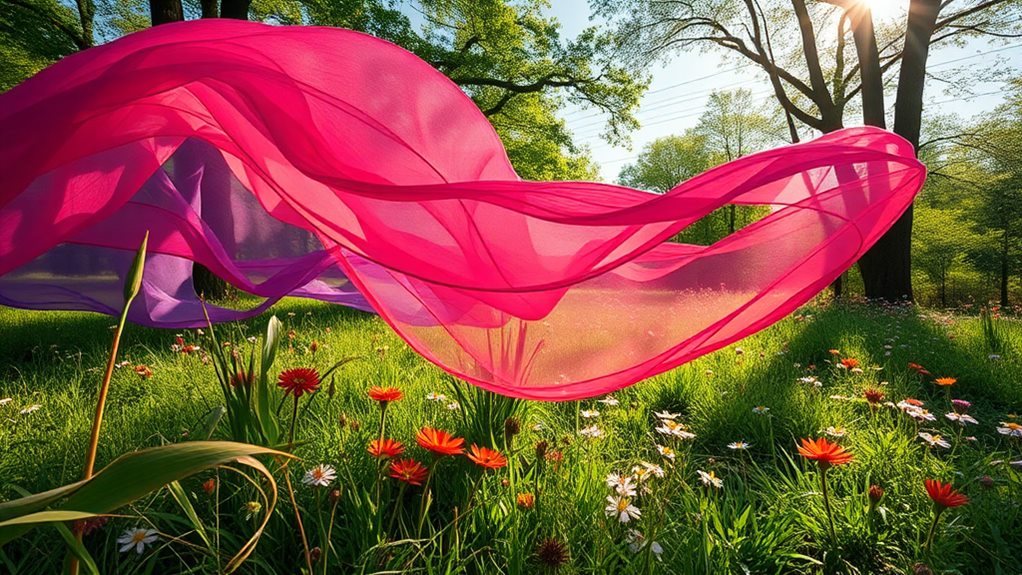Biodegradable fabrics play a critical role in sustainable fashion by reducing environmental waste dramatically compared to traditional synthetics. Options like organic cotton, hemp, and Tencel not only minimize harmful chemicals but also encourage a circular economy. However, recognizing truly eco-friendly products requires a discerning eye, as marketing can often mislead. While the demand for these materials is growing, obstacles like higher costs and consumer education gaps still challenge full adoption. Understanding these nuances helps shape responsible consumption habits, and there's much more to uncover about the innovations driving this movement toward a greener future.
Key Takeaways
- Biodegradable fabrics, like organic cotton and hemp, significantly reduce landfill waste compared to traditional textiles like polyester and nylon.
- The use of eco-friendly materials promotes environmental stewardship and minimizes harmful chemical usage in textile production.
- Consumer demand for sustainable products enhances brand loyalty and encourages companies to adopt greener practices.
- Innovations such as Tencel and mycelium leather exemplify the potential of biodegradable textiles in sustainable fashion.
- Adopting biodegradable fabrics supports a circular economy, driving collective action toward a more responsible fashion industry.
Understanding Biodegradable Fabrics
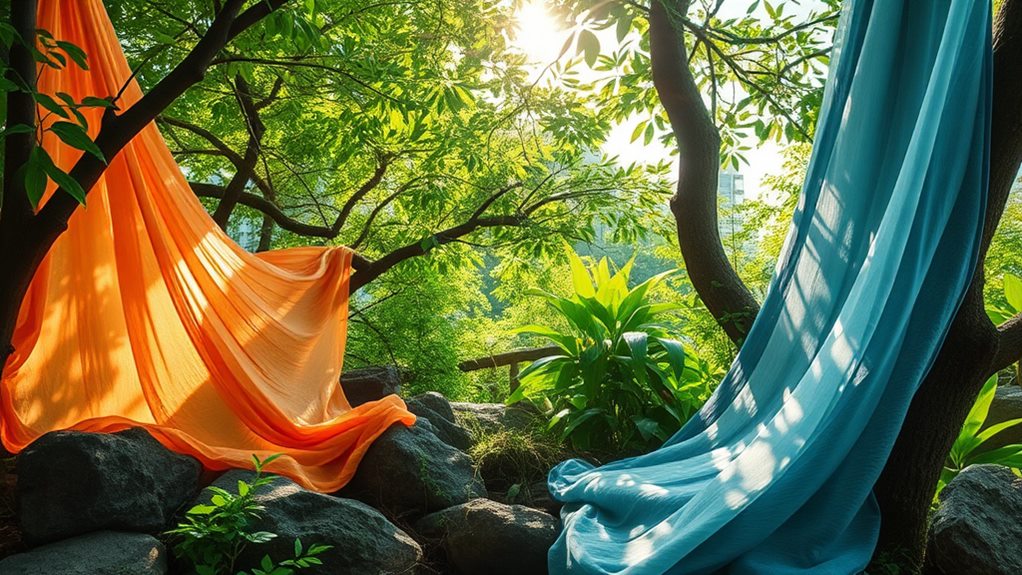
Understanding biodegradable fabrics is crucial for grasping their role in sustainable fashion. You might be surprised to learn that the environmental impact of traditional fabrics often outweighs the benefits of their use. Conventional materials, like polyester and nylon, can take hundreds of years to decompose, contributing to landfill waste and pollution.
In contrast, biodegradable fabrics, such as organic cotton, hemp, and Tencel, are designed to break down naturally, minimizing their ecological footprint. Many eco-friendly products, like a variety of sustainable dish soaps, emphasize the importance of natural ingredients and biodegradable properties, showcasing a growing trend towards environmental responsibility.
The biodegradability process is a crucial aspect to comprehend. It involves microorganisms, such as bacteria and fungi, breaking down organic materials into simpler compounds. This process not only reduces the volume of waste but also enriches the soil with nutrients, promoting a healthier ecosystem. However, not all biodegradable fabrics are created equal; some may require specific conditions—like industrial composting facilities—to decompose effectively.
It's important to scrutinize the claims made by brands regarding biodegradability. While some fabrics may advertise as biodegradable, they might still contain harmful chemicals or rely on unsustainable agricultural practices. This critical evaluation can help you make more informed choices, aligning your fashion consumption with your values. By understanding the environmental impact and the intricacies of the biodegradability process, you can foster a deeper connection with sustainable fashion and contribute to a more responsible industry. You belong to a community that cares about the planet, and knowledge is your first step toward meaningful change.
Benefits of Biodegradable Materials
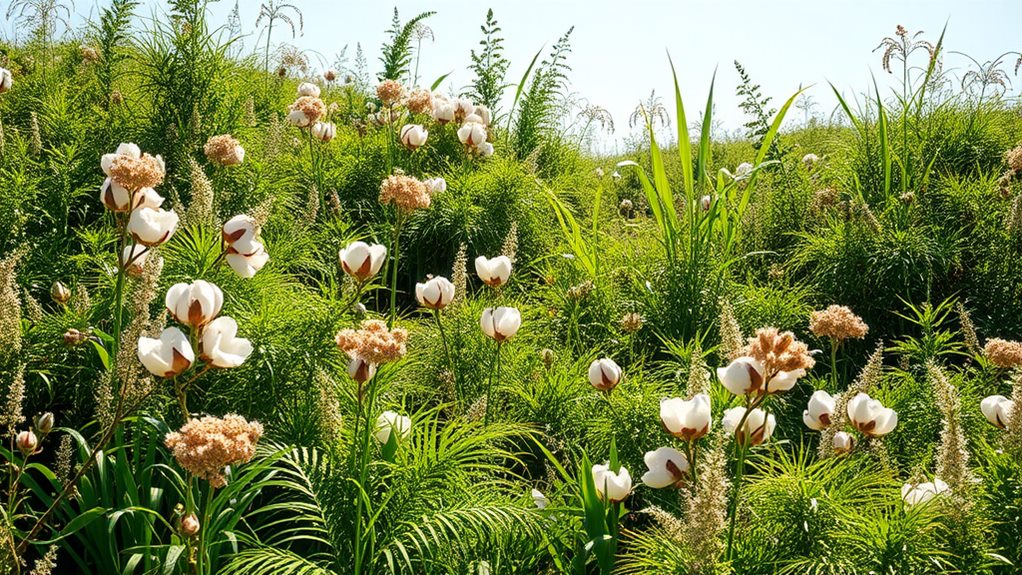
Embracing biodegradable materials offers a range of benefits that extend beyond individual fashion choices. By opting for these sustainable fabrics, you contribute positively to the environment, reducing the significant environmental impact associated with conventional textiles. Traditional fabrics often take decades, if not centuries, to decompose, whereas biodegradable options break down naturally, returning nutrients to the soil and minimizing landfill waste. Additionally, eco-friendly materials such as organic cotton and innovative textiles reduce the usage of harmful chemicals and promote responsible production methods, further enhancing their environmental benefits eco-friendly materials.
Moreover, as awareness of environmental issues grows, consumer demand for sustainable products is on the rise. You're not just making a personal choice; you're part of a larger movement advocating for responsible consumption. Brands that prioritize biodegradable materials often resonate with your values, fostering a sense of belonging within a community committed to sustainability. This shift in demand pushes the fashion industry to innovate, leading to a broader range of eco-friendly options that appeal to your aesthetic and ethical standards.
Additionally, choosing biodegradable fabrics can enhance your brand loyalty. When you support companies that align with your values, you foster deeper connections with them, creating a cycle of positive reinforcement for sustainable practices. By making conscious choices, you influence the marketplace, encouraging more brands to adopt eco-friendly materials and practices.
Types of Biodegradable Fabrics
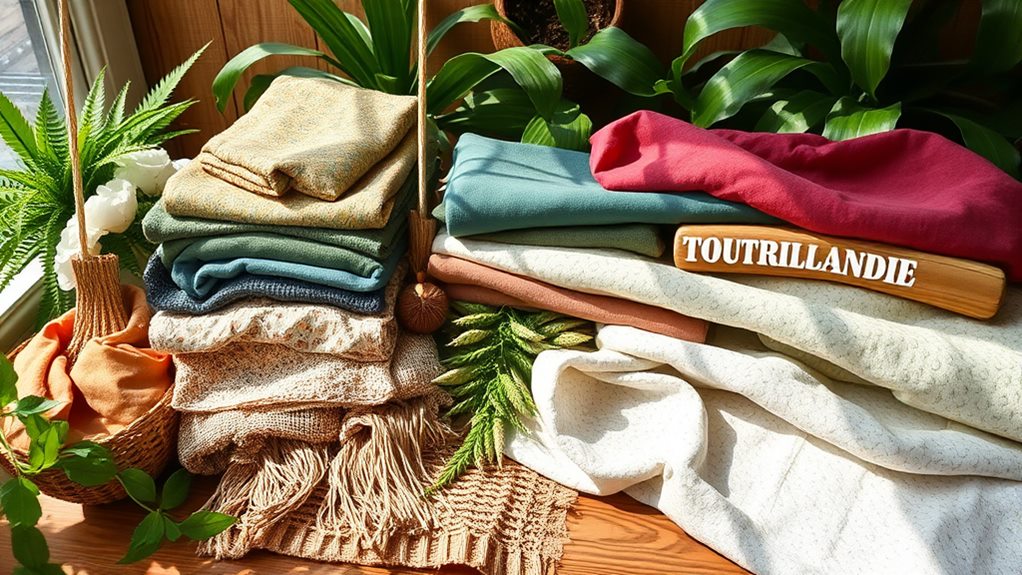
What types of eco-friendly fabrics can you find in today's sustainable fashion landscape? As you explore this domain, two standout materials are hemp textiles and bamboo fibers, each offering unique benefits and challenges.
Hemp textiles have gained popularity due to their durability and low environmental impact. Hemp plants require little water and no pesticides, making them a sustainable choice. The fabric itself is strong, breathable, and naturally resistant to mold and UV light. Additionally, similar to premium growing mediums, hemp's cultivation promotes healthier ecosystems. However, the production process can be energy-intensive, and the texture may not appeal to everyone. It's crucial to take into account how these factors align with your values in sustainable fashion.
On the other hand, bamboo fibers are celebrated for their softness and versatility. The fast-growing bamboo plant regenerates quickly and absorbs carbon dioxide more efficiently than many trees, contributing positively to the environment. However, not all bamboo fabrics are created equal.
The chemical process used to convert bamboo into fabric can be harsh, raising concerns about sustainability. You'll want to seek out brands that utilize eco-friendly methods, ensuring that your choices reflect your dedication to a greener future.
The Role of Sustainable Fashion

Sustainable fashion plays a central role in reshaping the industry by prioritizing ethical production and environmental stewardship. As a consumer, your choices can greatly impact the market dynamics, pushing brands toward more responsible practices. When you become aware of the consequences of your purchases, you not only empower yourself but also demand greater accountability from the industry.
The table below outlines key aspects of sustainable fashion that contribute to a more responsible industry:
| Aspect | Description |
|---|---|
| Consumer Awareness | Understanding the impact of fashion on the environment and society. |
| Eco-Friendly Choices | Opting for materials and brands that prioritize sustainability. |
| Ethical Production | Ensuring fair labor practices and transparency in the supply chain. |
| Industry Responsibility | Brands adopting eco-conscious practices to minimize environmental impact. |
| Community Engagement | Fostering a culture of sustainability through education and collaboration. |
By choosing eco-friendly options, you encourage brands to innovate and adopt greener practices. This shift isn't just about materials; it's a movement toward a holistic approach to fashion that encompasses ethical production, fair labor, and environmental respect. As you engage with sustainable fashion, you're not just a consumer—you become part of a community that values responsibility and mindfulness.
In this way, sustainable fashion can transform the industry, creating a future where clothing is not only stylish but also considerate of our planet and its people. Your role in this movement is essential; every small choice adds up to make a notable difference.
Challenges in Adoption
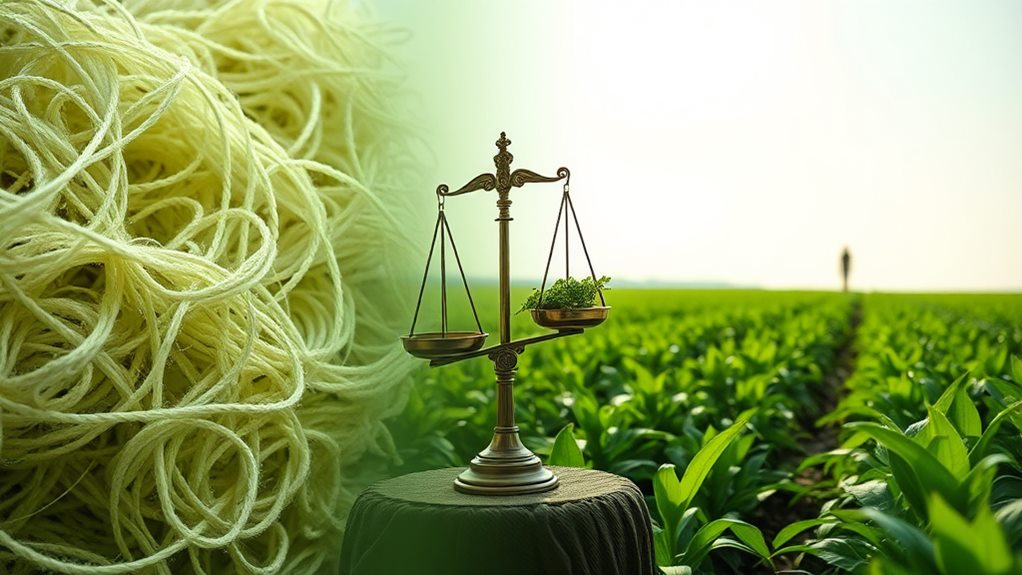
Many consumers encounter significant obstacles when attempting to adopt sustainable fashion practices. One of the primary barriers is the lack of consumer education surrounding biodegradable fabrics. You might find it challenging to navigate the overwhelming amount of information available, making it hard to distinguish between genuinely sustainable options and mere marketing tactics. Without adequate knowledge, it's easy to feel disconnected from the sustainable fashion movement.
Additionally, market demand plays a pivotal role in this transformation. When consumers like you express interest in sustainable options, brands respond. However, the current demand for biodegradable fabrics is still relatively low compared to traditional materials. This difference leads to higher production costs for companies that focus on sustainable practices. If you're concerned about affordability, you'll notice that these fabrics often come at a premium price, making them less accessible for everyday consumers.
Scalability is another hurdle. As companies strive to expand their offerings of biodegradable textiles, they often face obstacles related to manufacturing processes and resource availability. You might wish to support brands that prioritize sustainability, but if they can't scale up production efficiently, their impact remains limited.
In essence, overcoming these obstacles requires a collective effort. As you educate yourself and advocate for sustainable practices, you'll help create a market that demands more biodegradable options. It's about fostering a sense of belonging in a community that values sustainability and pushing brands to innovate and adapt.
Innovations in Biodegradable Textiles
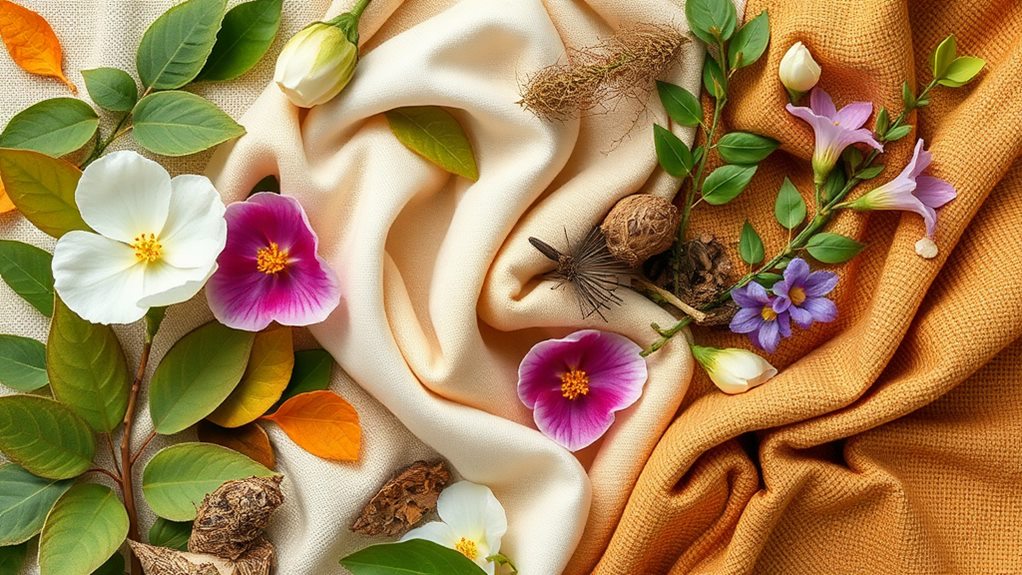
Recent advancements in biodegradable textiles are transforming the landscape of sustainable fashion, offering innovative solutions that address both environmental concerns and consumer needs. As you explore these eco-friendly alternatives, recognizing the fashion industry's progress in creating materials that not only reduce waste but also maintain quality and style is vital.
| Innovation | Description |
|---|---|
| Tencel | Made from sustainably sourced wood pulp, Tencel is biodegradable and compostable. |
| Piñatex | A leather alternative derived from pineapple leaves, offering a sustainable option for accessories. |
| Hemp | A fast-growing crop that requires minimal water and pesticides, making it a sustainable textile choice. |
| Mycelium Leather | Created from fungi, this innovative material mimics leather while being entirely biodegradable. |
| Recycled Cotton | Utilizing post-consumer cotton waste, this option reduces landfill waste while providing a familiar fabric. |
These innovations not only highlight the commitment of designers and brands to sustainability but also create a sense of belonging among consumers who prioritize eco-conscious choices. By opting for these biodegradable textiles, you're actively participating in a movement towards responsible consumption. However, it's vital to remain critical of the industry's marketing, ensuring that these claims of sustainability are backed by genuine practices. As you consider your own wardrobe, remember that each choice can contribute to a more sustainable future, reinforcing the collective effort toward a more responsible fashion landscape.
Future of Fashion Sustainability
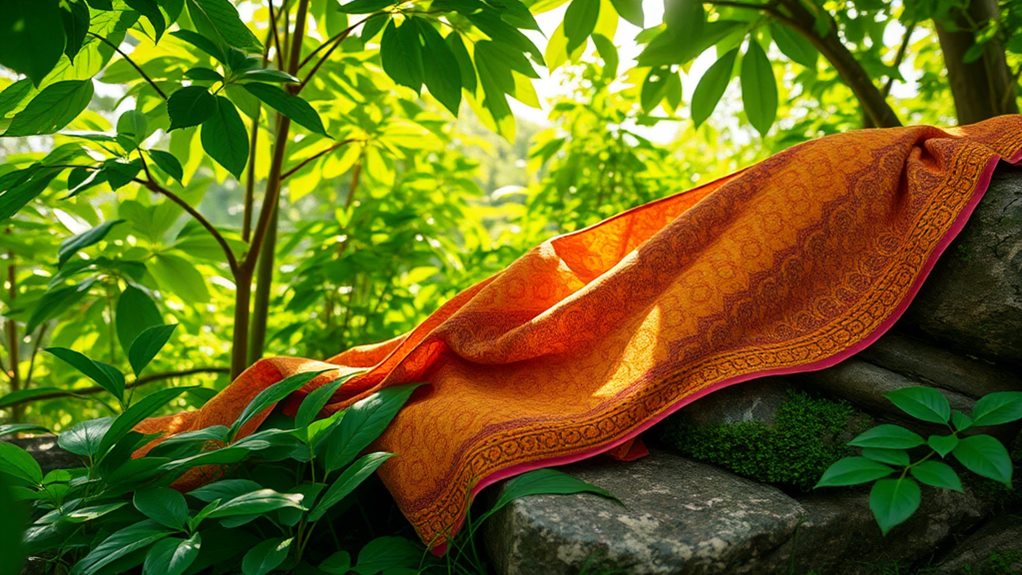
Envisioning the future of fashion sustainability reveals a landscape where innovative practices and technologies converge to redefine the industry. You might find yourself exploring a domain dominated by the principles of a circular economy, where waste is minimized, and resources are continuously repurposed. This model not only extends the lifecycle of materials but also fosters a sense of community, as brands and consumers collaborate to create sustainable solutions.
As you explore this future, you'll encounter a variety of eco-friendly alternatives that challenge traditional manufacturing processes. Think of fabrics made from recycled materials or crops that regenerate quickly, like hemp or bamboo. These options not only reduce environmental impact but also align with a growing consumer demand for transparency and ethical practices. You're likely to feel empowered by choosing brands that prioritize sustainability, reinforcing your sense of belonging to a conscientious community.
Moreover, advancements in technology, such as 3D printing and biofabrication, will enable you to witness the rise of customized fashion that meets your specific needs while minimizing waste. Imagine a world where your clothing can be produced on-demand, eliminating overproduction and fostering a more responsible consumption model.
Ultimately, the future of fashion sustainability hinges on collective action. By embracing the circular economy and supporting eco-friendly alternatives, you become part of a larger movement. This shift not only enhances your wardrobe but also contributes to the well-being of our planet, creating a fashion landscape that reflects your values and aspirations.
Frequently Asked Questions
How Do Biodegradable Fabrics Compare to Traditional Fabrics in Cost?
When you consider the cost comparison between biodegradable fabrics and traditional fabrics, it's clear that biodegradable options often come with a higher initial price. However, factoring in their recycling potential can shift your perspective.
Biodegradable fabrics may reduce long-term environmental costs and waste management expenses. By investing in these materials, you're not just paying for a product; you're contributing to a more sustainable future, fostering a sense of belonging in the eco-conscious community.
Can Biodegradable Fabrics Be Recycled After Use?
When considering whether biodegradable fabrics can be recycled after use, it's important to analyze their recycling potential. While some biodegradable materials can be repurposed, many aren't suited for traditional recycling processes. However, their environmental benefits, such as reducing landfill waste and breaking down naturally, make them an appealing option.
You'll need to research local facilities that accept these fabrics to maximize their lifecycle and contribute positively to a sustainable future.
What Is the Lifespan of Biodegradable Fabrics in Various Conditions?
The lifespan of biodegradable fabrics varies based on conditions like moisture and temperature. In ideal composting environments, these fabrics break down within months, offering significant composting benefits. However, in drier or colder settings, decomposition can take years, which could impact your environmental goals. Understanding these factors helps you make informed choices, aligning your wardrobe with sustainability.
Prioritizing biodegradable options can foster a sense of belonging to a community committed to reducing waste and enhancing eco-friendliness.
Are There Any Certifications for Biodegradable Textiles?
Imagine strolling through a lush, green forest, where every leaf and petal thrives in harmony.
When it comes to biodegradable textiles, certification standards like Global Organic Textile Standard (GOTS) and OEKO-TEX confirm these fabrics meet environmental benefits.
These certifications guarantee that your choices align with sustainability, offering peace of mind.
How Can Consumers Identify Biodegradable Fabric Products?
To identify biodegradable fabric products, you should look for eco-friendly labeling on clothing. These labels often indicate the material's environmental benefits and its ability to decompose naturally.
Consumer education is key; understanding the differences between synthetic and natural fibers can help you make informed choices.
Research brands that prioritize sustainability and transparency, as they're more likely to offer biodegradable options, fostering a sense of belonging in the eco-conscious community.
Conclusion
In the rapidly evolving landscape of sustainable fashion, biodegradable fabrics emerge as the lifeboat sailing through the turbulent waters of textile waste. Their benefits, from reducing landfill impact to promoting eco-friendly practices, are undeniable. However, challenges like scalability and consumer awareness persist. As innovations continue to blossom, embracing these materials could redefine our relationship with fashion, guiding us toward a more sustainable future. Ultimately, your choices today can plant the seeds for a greener tomorrow in the fashion industry.

